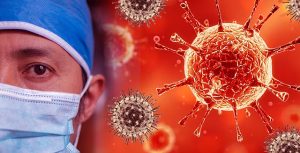Deficient selenium status is associated with an increased risk of COVID-19 as well as with greater risk of chronic inflammatory diseases and viral infections. However, the biological mechanisms by which selenium deficiency might cause weakened immune function and elevated inflammation are not clearly identified as yet [Golin 2023].

The coronavirus 2, known as SARS-CoV-2, causes COVID-19 illness. COVID-19 is an illness that has infected millions of individuals since late 2019. Acute respiratory syndrome and pro-inflammatory cytokine storms are manifested in the worst of COVID-19 cases. The severity of COVID-19 illness is associated with several factors: age, health status, sex, and selenium deficiency [Golin 2023].
Selenium Deficiency and COVID-19 Illness
In clinical trials, selenium supplementation has shown a protective role against some viral illnesses, e.g., HIV-1 virus, hantavirus, and hepatitis-B [Rayman 2023]. The antioxidant effects of some selenium containing selenoproteins help to modulate immune system function and inflammatory responses. Accordingly, some researchers have sought to establish a link between selenium deficiency and the risk of contracting COVID-19 [Golin 2023].
Zhang 2020 study
In China, Zhang et al collected data on confirmed COVID-19 cases, recoveries, and deaths. The researchers observed an association between COVID-19 patients’ higher hair selenium concentrations and COVID-19 patients’ recovery rates. There was a significant positive linear relationship between regional selenium status and the cure rate of patients with COVID-19. Higher selenium status correlated positively with higher cure rates [Zhang 2020].
Interestingly, the cure rate continued to rise beyond the optimal selenium intake needed for the synthesis of selenoproteins. This suggests that the activity of selenoproteins is part of the protection against viral infections but that other mechanisms are also involved [Zhang 2020].
Moghaddam 2020 study
In a cross-sectional study, Moghaddam et al. reported higher serum selenium and SELENOP levels in COVID-19 survivors (median: 69 years) than in non-survivors (median: 89 years). Unfortunately, Moghaddam did not report any adjustment to the data for the effect of age on the outcome [2020].
Alehagen 2022 KiSel-10 sub-study
Structural equation modeling of the data in the Swedish KiSel-10 study showed that combined selenium and CoQ10 supplementation is associated with significantly reduced levels of oxidative stress and chronic inflammation [Alehagen 2022].
Selenium Deficiency and Severity of Viral Infections

In a 2023 review, Rayman et al point to the work of Melinda Beck to explain the relationship between selenium deficiency and the severity of viral infections. Beck’s research showed that both the strength of the virus and the state of the host’s nutritional status and redox environment determine the severity and the evolution of viral infections.
Beck’s work with mice showed the following relationships [Beck 2003; Beck & Levander 2000]:
- Non-virulent viruses becoming virulent in selenium-deficient hosts
- Increased viral disease severity in selenium-deficient hosts
- Oxidative stress enabling viral mutation
- Deficiency of the glutathione peroxidase selenoprotein associated with higher oxidative stress in host cells, leading to greater viral genome instability and more mutations
Conclusions: Selenium Deficiency and COVID-19 and other Viral Infections
Deficiencies of essential micronutrients like selenium can have global health consequences.
Selenium deficiency in hosts can induce mutations in viruses and make relatively harmless viruses into dangerous viruses.
Selenium-deficient hosts are vulnerable to more severe viral disease because their inflammatory response is badly regulated.
Decreased glutathione peroxidase activity leads to increased oxidative stress and triggers viral genome instability.
Selenium deficiency is a factor in the severity of viral infections.
Sources
Alehagen U et al. Improved cardiovascular health by supplementation with selenium and coenzyme Q10: applying structural equation modelling (SEM) to clinical outcomes and biomarkers to explore underlying mechanisms in a prospective randomized double-blind placebo-controlled intervention project in Sweden. Eur J Nutr. 2022 Sep;61(6):3135-3148.
Beck MA. Selenium deficiency and viral infection. J Nutr. 2003;133(5 Suppl):1463S–1467S.
Beck MA & Levander OA. Host nutritional status and its effect on a viral pathogen. J Infect Dis. 2000;182(Suppl 1):S93–96.
Beck MA. Selenium and host defence towards viruses. Proc Nutr Soc. 1999;58(3):707–711.
Beck MA et al. Selenium deficiency increases the pathology of an influenza virus infection. FASEB J. 2001;15:1481–1483.
Beck MA et al. Host nutritional selenium status as a driving force for influenza virus mutations. FASEB J. 2001;15(10):1846–1848.
Golin A et al. Relationship between selenium status, selenoproteins and COVID-19 and other inflammatory diseases: A critical review. J Trace Elem Med Biol. 2023 Jan;75:127099.
Moghaddam A et al. Selenium deficiency is associated with mortality risk from COVID-19. Nutrients. 2020 Jul 16;12(7):2098.
Rayman MP et al. The relevance of selenium to viral disease with special reference to SARS-CoV-2 and COVID-19. Proc Nutr Soc. 2023 Feb;82(1):1-12.
Zhang J et al. Selenium and selenoproteins in viral infection with potential relevance to COVID-19. Redox Biol. 2020 Oct;37:101715.
The information presented in this review article is not intended as medical advice. It should not be used as such.
